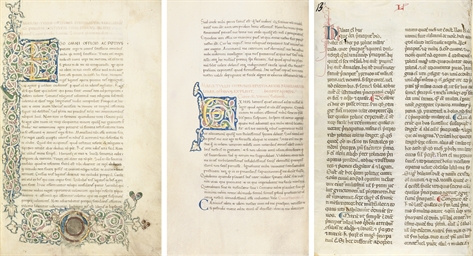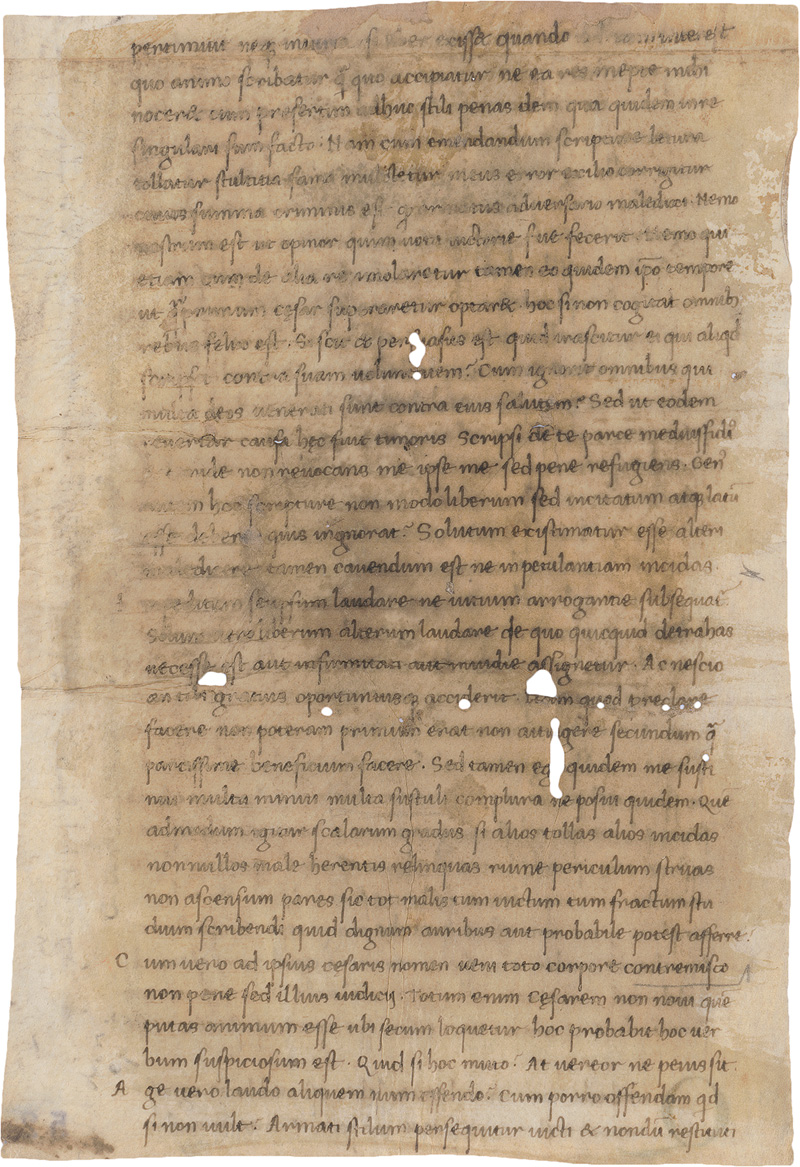CICERO, Marcus Tullius, Epistolae ad Familiares , in Latin, illuminated manuscript on vellum, written by Ser Pietro di Bernardo Cennini and illuminated by Francesco di Antonio del Chierico [Florence, c. 1460-1470]. A splendid example of Florentine humanist book production: a manuscript of one of the great texts of Classical Antiquity, illuminated by the leading illuminator in Florence in the second half of the 15th century, Francesco di Antonio del Chierico, and written by the Florentine poet, artist and scribe Pietro Cennini. 270 x 175mm. i + 156 + iii leaves, complete, modern foliation in pencil 1-156 followed here. 36 lines of text, ruled space: 195 x 105mm, vertical catchwords survive. Two-line initials in dark blue throughout, 16 large white-vine initials in raised burnished gold, the first with a two-sided border with winged putti carrying a wreath (original arms erased), a bird and a butterfly (blue pigment on opening leaf retouched and burnished gold recently restored, lower corner of opening folio slightly thumbed, a few contemporary marginal notes, erasure at end affecting several pages, a few minor wormholes mostly in margins). Late 16th-century gold-tooled olive morocco, perhaps Sicilian (see La Bibliofilía , vol. 68 [1966], pp.181-183), gilt edges (covers a little worn, small sections missing from head and foot of spine); vellum pastedowns (lifted) from a mid-14th-century Italian manuscript of Aristotle's Politics , Book 4, in Latin translation written in 2 columns. Modern quarter red morocco fitted box with gilt lettering. Provenance: Unidentified original owner, his coat of arms on f. 2 erased – Perhaps a Sicilian owner by the late 16th-early 17th century when the manuscript received its present binding, presumably contemporary to the inscriptions on the flyleaf: ‘Di don Fran[ces]co f.f.lia. / Di D[on] Domenico – Giannalisa Feltrinelli (1903-1981), her bookplate inside upper cover; F 159 in her library; her sale at Christie’s London, 3 December 1997, part II, lot 151 – Helmut N. Friedlaender (1913-2008), American bibliophile and lawyer, his bookplate on inside upper cover; his library sold at Christie’s New York, 23 April 2001, lot 5 – Christie’s London, 3 June 2009, lot 17 – Bookplate with initials R.L.A on inside upper cover. Content: Epistolae ad familiares (ff.2-156v), in sixteen books: Book I (f. 2), Book II (f.11v), Book III (f.18v), Book IV (f.27v), Book V (f.35), Book VI (f.46v), Book VII (f.56v), Book VIII (f.66), Book IX (f.70v), Book X (f.84v), Book XI (f. 98v), Book XII (f.107), Book XIII (f.118), Book XIV (f.130v), Book XV (f.140), Book XVI (f.150). The selection of letters — to family members, acquaintances, colleagues — that comprise Cicero's Epistolae ad familiares gives a candid and intimate insight into the great Roman politician's life and opinions, conveying a vivid sense of a momentous period in Roman history, and the manner in which Cicero viewed his own legacy. In 1392, Coluccio Salutati (1374-1406), the humanist chancellor of Florence, discovered the letters in the Cathedral library at Verona. The Epistolae ad familiares was among the first books printed in Italy. Script and Illumination : The handsome border of the opening leaf and the finely-executed white-vine initials which open each book can be securely attributed to Francesco di Antonio del Chierico, the preferred illuminator of the greatest institutional and private patrons of Florence from the 1450s until his death in 1484. Through Vespasiano da Bisticci, Francesco di Antonio came to work for princely patrons throughout Europe, including Federico da Montefeltro, Duke of Urbino, Ferdinand I, King of Naples, Louis XI of France and Matthias Corvinus, King of Hungary. The most discerning commissioners of Florentine books turned to him; but it was with the de' Medici that he had an especially close relationship. From the time of Cosimo il Vecchio to Lorenzo il Magnifico he illustrated manuscripts for them, ranging from gia
CICERO, Marcus Tullius, Epistolae ad Familiares , in Latin, illuminated manuscript on vellum, written by Ser Pietro di Bernardo Cennini and illuminated by Francesco di Antonio del Chierico [Florence, c. 1460-1470]. A splendid example of Florentine humanist book production: a manuscript of one of the great texts of Classical Antiquity, illuminated by the leading illuminator in Florence in the second half of the 15th century, Francesco di Antonio del Chierico, and written by the Florentine poet, artist and scribe Pietro Cennini. 270 x 175mm. i + 156 + iii leaves, complete, modern foliation in pencil 1-156 followed here. 36 lines of text, ruled space: 195 x 105mm, vertical catchwords survive. Two-line initials in dark blue throughout, 16 large white-vine initials in raised burnished gold, the first with a two-sided border with winged putti carrying a wreath (original arms erased), a bird and a butterfly (blue pigment on opening leaf retouched and burnished gold recently restored, lower corner of opening folio slightly thumbed, a few contemporary marginal notes, erasure at end affecting several pages, a few minor wormholes mostly in margins). Late 16th-century gold-tooled olive morocco, perhaps Sicilian (see La Bibliofilía , vol. 68 [1966], pp.181-183), gilt edges (covers a little worn, small sections missing from head and foot of spine); vellum pastedowns (lifted) from a mid-14th-century Italian manuscript of Aristotle's Politics , Book 4, in Latin translation written in 2 columns. Modern quarter red morocco fitted box with gilt lettering. Provenance: Unidentified original owner, his coat of arms on f. 2 erased – Perhaps a Sicilian owner by the late 16th-early 17th century when the manuscript received its present binding, presumably contemporary to the inscriptions on the flyleaf: ‘Di don Fran[ces]co f.f.lia. / Di D[on] Domenico – Giannalisa Feltrinelli (1903-1981), her bookplate inside upper cover; F 159 in her library; her sale at Christie’s London, 3 December 1997, part II, lot 151 – Helmut N. Friedlaender (1913-2008), American bibliophile and lawyer, his bookplate on inside upper cover; his library sold at Christie’s New York, 23 April 2001, lot 5 – Christie’s London, 3 June 2009, lot 17 – Bookplate with initials R.L.A on inside upper cover. Content: Epistolae ad familiares (ff.2-156v), in sixteen books: Book I (f. 2), Book II (f.11v), Book III (f.18v), Book IV (f.27v), Book V (f.35), Book VI (f.46v), Book VII (f.56v), Book VIII (f.66), Book IX (f.70v), Book X (f.84v), Book XI (f. 98v), Book XII (f.107), Book XIII (f.118), Book XIV (f.130v), Book XV (f.140), Book XVI (f.150). The selection of letters — to family members, acquaintances, colleagues — that comprise Cicero's Epistolae ad familiares gives a candid and intimate insight into the great Roman politician's life and opinions, conveying a vivid sense of a momentous period in Roman history, and the manner in which Cicero viewed his own legacy. In 1392, Coluccio Salutati (1374-1406), the humanist chancellor of Florence, discovered the letters in the Cathedral library at Verona. The Epistolae ad familiares was among the first books printed in Italy. Script and Illumination : The handsome border of the opening leaf and the finely-executed white-vine initials which open each book can be securely attributed to Francesco di Antonio del Chierico, the preferred illuminator of the greatest institutional and private patrons of Florence from the 1450s until his death in 1484. Through Vespasiano da Bisticci, Francesco di Antonio came to work for princely patrons throughout Europe, including Federico da Montefeltro, Duke of Urbino, Ferdinand I, King of Naples, Louis XI of France and Matthias Corvinus, King of Hungary. The most discerning commissioners of Florentine books turned to him; but it was with the de' Medici that he had an especially close relationship. From the time of Cosimo il Vecchio to Lorenzo il Magnifico he illustrated manuscripts for them, ranging from gia















Testen Sie LotSearch und seine Premium-Features 7 Tage - ohne Kosten!
Lassen Sie sich automatisch über neue Objekte in kommenden Auktionen benachrichtigen.
Suchauftrag anlegen